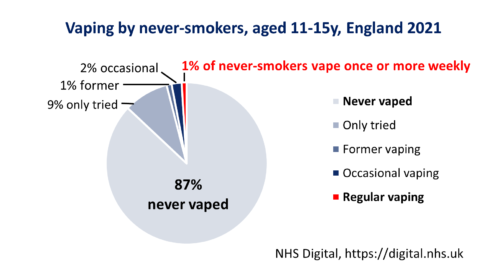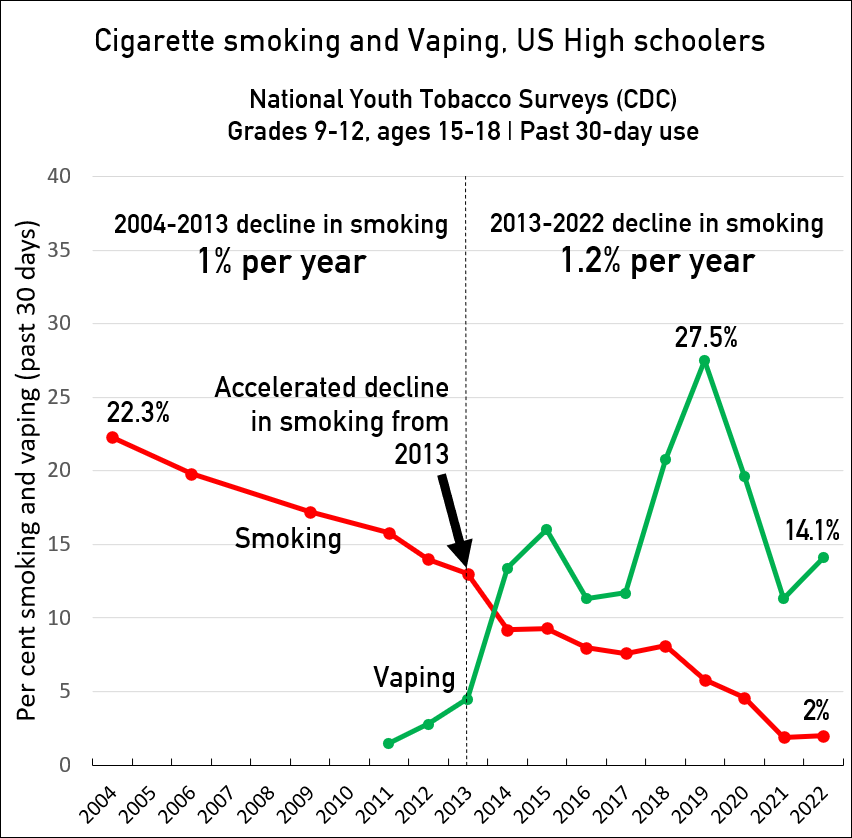
What does the evidence say about youth vaping? – study
Posted on May 30, 2023 By Colin
EVERYONE AGREES that young people should not vape or smoke. However, the current fear and panic about youth vaping is not based on the evidence, according to our peer-reviewed paper published today in the International Journal of Drug Policy.
The main concern is vaping by young people who have never smoked (never-smokers) and we reviewed the evidence for this group. Vaping among young people who already smoke may be beneficial if it diverts them away completely from cigarette smoking.
This 5-minute video outlines the key issues
Frequent vaping by never-smokers is rare
Most vaping by adolescents who have never smoked is occasional and short-term. Frequent vaping in this group is uncommon - <2% in international surveys
For example, in England in 2021 only 1% of 11-15-year-olds who had never smoked cigarettes vaped regularly (once or more weekly).

Young people who vape occasionally are exposed to very low levels of chemicals and the risks are likely to be small.
Vaping is diverting young people away from smoking
Young people who try vaping are also more likely to smoke, drink alcohol and use illicit drugs, but there is no good evidence that vaping CAUSES them to take up smoking if they would not have otherwise done so (the gateway theory).
In fact, the evidence suggests the opposite. Increased youth vaping has been accompanied by an accelerated decline in youth smoking
This is evident in many western countries, such as the US:

This suggests that even if there is a small gateway effect it is outweighed by the much larger number moving from smoking to vaping.
The health effects of vaping are small
Because most vaping by young people who have never smoked is infrequent and short-term, they are exposed to lower levels of exposure and are likely to have fewer adverse health effects
There is no clear evidence that vaping causes "clinically significant" lung symptoms or asthma.
High doses of nicotine can harm the adolescent brain in animal studies but there is no evidence of harm in humans. Even smoking has not been found to impair IQ, educational achievement or cognitive abilities later in life, so it is very unlikely that vaping will.
Nicotine withdrawal can cause short-term symptoms such as irritability, restlessness, anxiety, difficulty concentrating and depression. Nicotine otherwise causes little harm in the doses commonly used in vaping. Nicotine does not cause cancer or lung disease and it has only a minor role in cardiovascular disease.
Vaping nicotine does NOT cause the serious lung disease E-cigarette or Vaping Associated Lung Injury (EVALI), or seizures. There is a rare risk of burns and injuries from lithium-battery explosions, but none have been reported from disposables, the most popular type of device used by young people.
The precise long-term effects of vaping nicotine will not be fully known for decades. Effects from long-term vaping may include cardiovascular and respiratory effects. Ongoing monitoring and long-term studies are essential to detect any problems that may arise in the future, particularly from sustained frequent vaping.
Nicotine dependence in never-smokers is very uncommon
Vaping can cause nicotine dependence in some young people who have never smoked. However, this is only in a small minority of cases, not, as the media often claim, a “new generation addicted to nicotine”
An analysis of the 2018 US National Youth Tobacco Survey found that <4% of young people who had vaped in the past 30 days but had never smoked had signs of nicotine dependence. This is to be expected as the dominant pattern of use is occasional and short-term.
Nicotine dependence is mostly concentrated in young people who have previously or currently smoke.
What are the risks for smokers?
Many teens who smoke use e-cigarettes to quit smoking or as a safer alternative. Vaping is not harmless, but is likely to be far less harmful than smoking and those who switch from smoking to vaping are likely to see health benefits.
How to reduce youth vaping
Teens should be given honest and accurate information about vaping. There is no place for fear and misinformation. See my advice here.
Teens mostly get their vapes from black market sources, either from rogue convenience stores and tobacconists or through social media.
The black market was created by the current prescription model. It is so difficult for adults to access legal vapes to quit smoking, that a black market has sprung up to service them. Only 2% of adults buy their vapes from a pharmacy with a prescription.
Addressing the black market is the key to reducing youth vaping. The only way to eliminate the black market is to replace it with a legal, regulated one
This means selling nicotine vapes as adult consumer products from licensed retail outlets as for tobacco and alcohol, with strict age verification and harsh penalties for breaches such as high fines and loss of licence.
This would bring Australia into line with all other western countries.
Most adults would prefer to buy vapes from legal, regulated outlets. The black market would become less profitable and be largely replaced over time.
References
Mendelsohn CP. It’s time to change the way we look at youth vaping. Filter Magazine, 14 July 2023